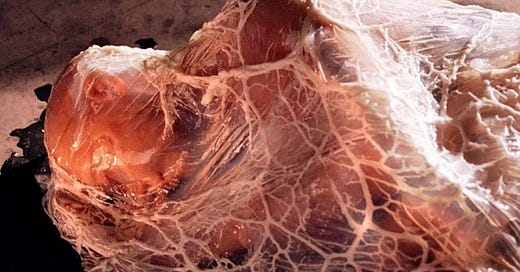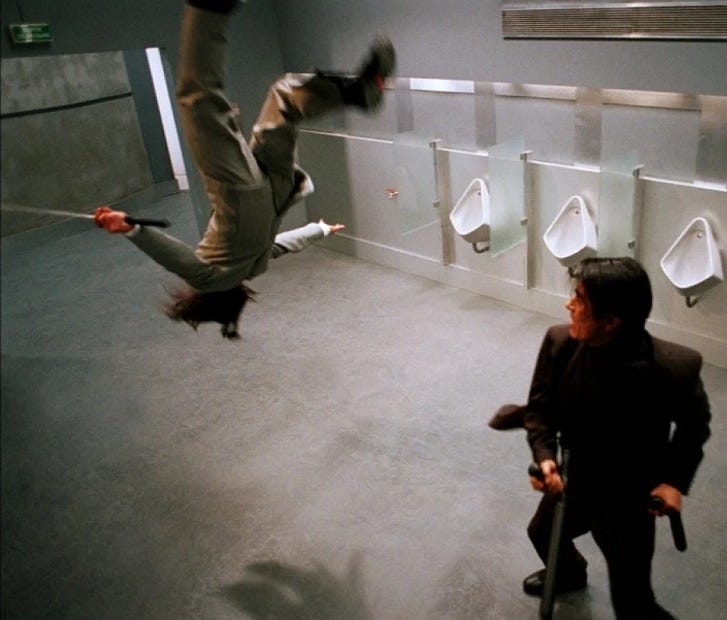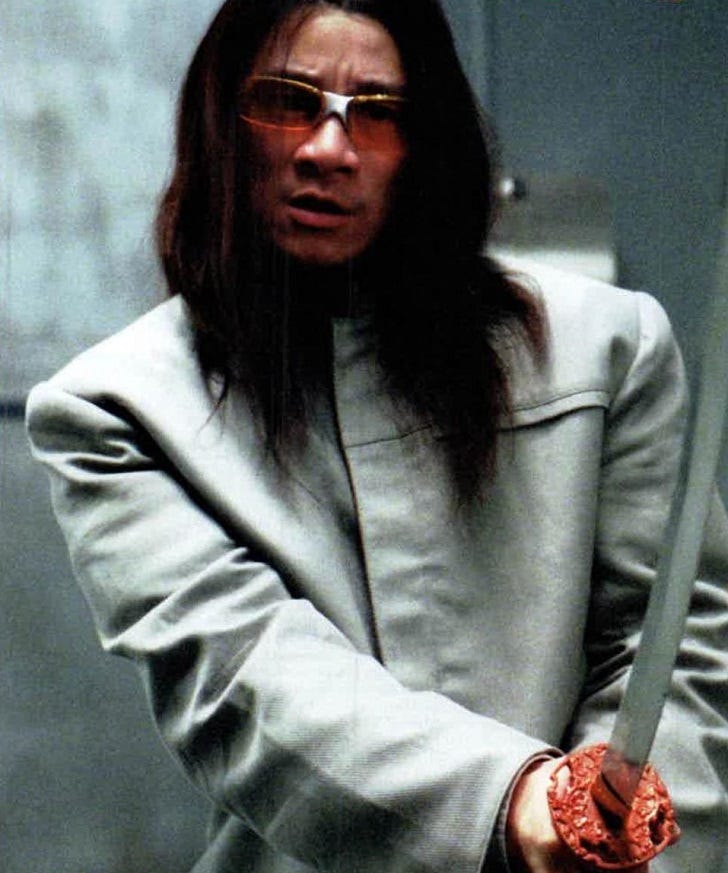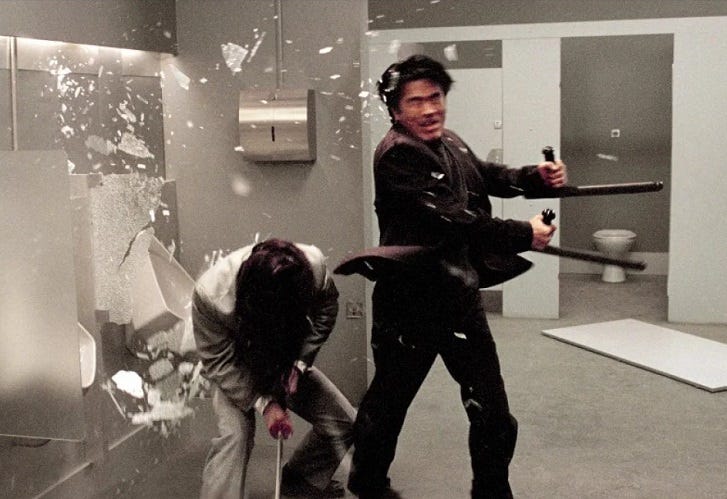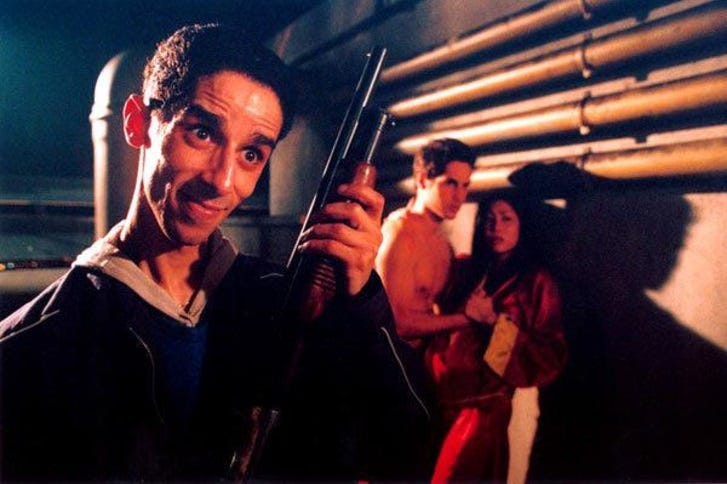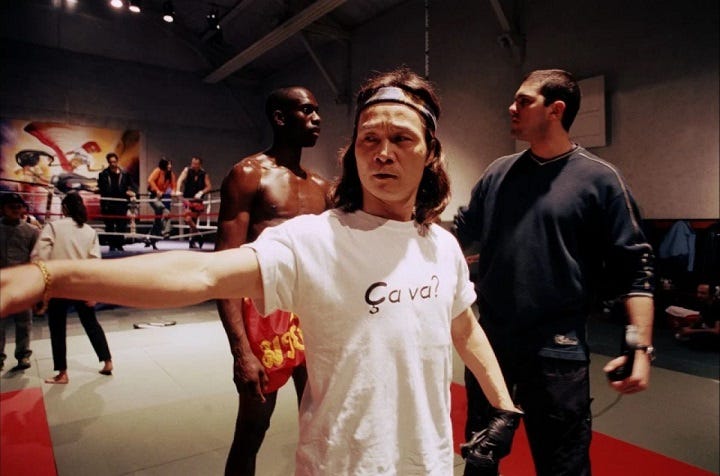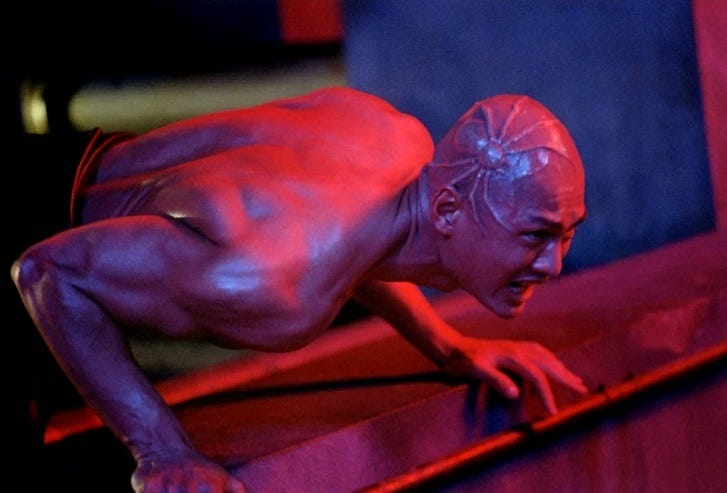This is an overlooked 2002 film. From Le Samouraï to Samouraïs, French cinema had come a long way. The reason why this film caught my attention is because Yasuaki Kurata had a supporting role in it. It also doesn’t hurt that the fight choreographer is Phillip Kwok (a.k.a Kuo Chui), who had previously worked on a 2001 French film called Brotherhood of the Wolf. As for Samouraïs, the quality of the fight scenes is assured by the hiring of a Hong Kong cinematographer, Tony Cheung Tung-Leung, who had worked on Jackie Chan’s Drunken Master II (1994).
He had also worked on Jet Li’s Black Mask (1996), whose villain had an influence on the look of the below backflipping stuntman in Samouraïs. On the subject of stuntmen, the following Hong Kong stuntmen had worked on Samouraïs - Kong Foo-Keung and Wong Wai-Tong. Two other H.K. stuntmen deserve to be singled out i.e. Jackie Yeung Tak-Ngai and Paco Yick Tin-Hung had previously worked with Phillip Kwok not only on Brotherhood of the Wolf but Tomorrow Never Dies as well.
Producer Marc Missionnier was interviewed in the 134th issue (September 2001) of a French magazine called Mad Movies. The budget of the film was 50 million francs, but this French currency became obsolete in March 2002 - three months before the film was released in France. It was a box office flop, so it probably could have done with cameos peppered throughout to compensate for the main star not being a box office draw. Contrast this film with the approach used on Abduction (2011) where Taylor Lautner became a leading man after having been established as a martial arts actor on Shadow Fury (2001).
The director of Samouraïs, an Italian guy named Giordano Gederlini, wasn’t entirely new to the world of film since he had directed one short in 1998. I’m basing this observation on browsing the Internet Movie Database, but Marc’s interview has a surprise in store: “Giordano has already made some very convincing short films. Camping Sauvage in particular. He also directed parts of The Jamel Show. His gifts for directing and directing actors are evident when watching his short films. He's also someone who knows exactly what he wants and what he's talking about. Asian cinema, for example, is something he knows like the back of his hand. He even practices martial arts.”
Just to digress, Nghi Hoang (the stuntman above) reminds me of Francis Ng’s villain character in Wong Jing’s God of Gamblers: The Early Stage. This was released in the same year as the aforementioned Black Mask. Nghi Hoang’s anglicized name owes a debt to the producer of Samouraïs. Hoang became known as Marc starting with The Transporter (also released in 2002). This was also a martial arts action film with a Hong Kong influence i.e. Corey Yuen Kwai was the fight choreographer. Hoang had already worked with Corey Yuen by being Jet Li’s stunt double in Kiss of the Dragon, a French production like The Transporter.
Naturally, Hoang worked with Jet again on Danny the Dog (2005). The difference is that he was working under the authority of fight choreographer Yuen Woo-Ping. Hoang went on to work with Jackie Chan in Rush Hour 3 (2007), Michelle Yeoh in Babylon A.D. (2008) and Jean-Claude Van Damme in JCVD (2008). He choreographed Mike Tyson in Les Portes du Soleil: Algérie Pour Toujours (2014), and his last film was Kate Beckinsale’s Canary Black (2024). Back to Samouraïs, it adds to his appeal that he worked on two France-based films that had Japanese titles i.e. Ronin (1998) and Wasabi (2001). Both films feature Jean Reno.
As for what was said about the budget of Samouraïs, producer Marc Missionnier said: “In my opinion, it's wrong to think that a first film must automatically be low-budget. So it's rare, yes, but that's because action films in France are rare. Besson, on the other hand, entrusts big budgets to young directors. Chris Nahon, on Kiss of the Dragon, got 200 million francs. So you have to find someone with whom you get along well on a human level, and who you give the means to express their talent. And I think a big budget provides appreciable comfort when making a first film.”
As for the scheduling of the fight scenes, Missionnier said: “For a fight scene, if you don't have six days to shoot it, it's useless. And six days is expensive. Giordano and I talked a lot about the film beforehand. We chose the team together, we made storyboards... It's real teamwork. There's real communication between us, and that's what counts. Moreover, the shoot went well, and the rushes are fantastic. We're really very happy and remain confident for the future.”
How the financing was raised without any internationally recognized stars: “It's the story itself that prevented us from contacting stars, since the heroes are twenty years old and there are no twenty-year-old stars in France. Or else, we would have to use slightly older actors, but the public isn't fooled. The financiers, however, posed no problem. Of course, we had to show credible actors, and we did a lot of tests. But in Pathé and M6, we found partners who were attentive to the genre. Because the real stars remain the story, the genre, the fights. We have finally reached a stage in France where it has become possible to make films with substantial budgets without the help of stars, but with other elements that attract financiers and even the public.”
The release date was already planned before the film is finished. That was rare as interviewer Stéphane Moïssakis observed, to which Monsieur Missionnier said: “Samouraïs is released on March 27, 2002. First of all, it's a very good date since it's the day before the Easter holidays. And then it's part of a strategy in which we are rather sure of ourselves: it's an ambitious film - an action film that has everything going for it, and so we want to position it very early on at a favorable date in order to exist in this niche. We are targeting young audiences above all, between twelve and twenty-five years old, but we think there are enough cultural or aesthetic elements that will allow us to reach an even wider audience.”
Like what Jackie Chan said, there is a difference between action and violence. Mr. Missionnier defined the film: “It's a film with highly choreographed, very spectacular fights, but there's no blood spurting, nothing complacent about the violence. It's very playful. And then there's a lot of comedy. It's basically an action comedy film; there's no real equivalent in France.”
They actually filmed in Japan but the Japanese producer is a silent partner if the lack of credit is anything to go by: “It wasn't easy, because it's always tricky to move a crew abroad. It's expensive, but we couldn't cut it; it was an integral part of the project, and there was no question of overlooking this challenge. We shot a lot of interiors in France to save on the budget, but the exteriors were shot in Tokyo and in a temple. We had a very professional executive producer, the same one who produced Eureka and Sogo Ishii's Gojoe.”
Fight choreographer Phillip Kwok is the above Chinese man. Anyway, the budget did swell because of the filming in Japan, maybe too swollen for its own good: “Initially, Samouraïs was supposed to cost twelve million. It was impossible to make a film of this magnitude with such a modest sum. Either we reduced the scope of the project or we made it more expensive. The reaction from Pathé was excellent; they encouraged the director to let loose, to go a little further with certain special effects scenes, with the aesthetics, with the spectacular side. In the end, this will result in a real action film. The audience will get their money's worth, that's for sure.”
Multi-platform advertising given the nature of the film’s plot: “It would be too expensive to create a real video game for the needs of the film. At the same time, it would be a good idea to create a game to accompany the release of Samouraïs. Especially since it would be frankly appropriate for the film's universe. But you know, video game companies in France are doing very badly at the moment; they mainly operate on the franchise. They need a strong title, a proven success. Taxi only got a video game after the release of the second film. In Samouraïs, even though the video game universe is an integral part of the film, success is not guaranteed. Let's imagine that our film is successful; if we make a sequel, then it will be possible to create a video game based on it.”
Marc’s marketing: “We're not going to make a fuss like Brotherhood of the Wolf because, mind you, it doesn't have the same budget. But we're definitely going to release Samouraïs in a nice mix of theaters. We're going to get people talking about it, which is already the case. I have the impression that it's an interesting subject; it's also very original. We've never made a film like this in France. That's why I also hope the film will work. Not just for us, but also to allow other directors to take this path and obtain comfortable budgets to make their first feature film.”

